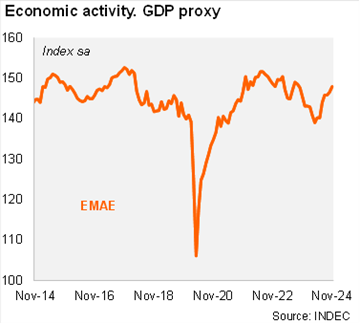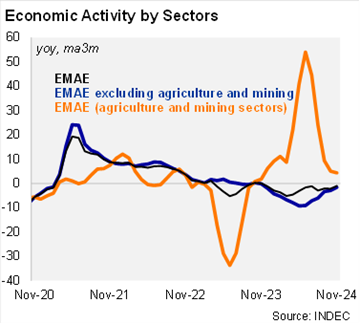Activity rose sequentially in November. According to the EMAE (official monthly GDP proxy), economic activity expanded by 0.9% MoM/SA in November, following a 0.60% MoM/SA growth in October. Thus, activity expanded by 2.4% QoQ/SA in November, after growing 3.3% QoQ/SA in the previous month. On an annual basis, activity rose by 0.1% and contracted by 1.1% in the quarter ended in November (-2.1% yoy in 3Q24). We note that the seasonally adjusted GDP proxy exceeded the level of December 2023, leaving the recession behind and a statistical carryover of 2.4% for 2024.

Most of the sectors fell on an annual basis (but at a softer rate), as the effects of the stabilization measures fade. Construction fell by 14.7% YoY in the period (from -14.9% YoY in 3Q24), affected by the freezing of public works, while manufacturing contracted by 3.5% YoY in the same period (vs. a drop of 5.9% YoY in 3Q24). Services (including the commerce sector) fell by 2.6% YoY in the period (vs. -3.1% in 3Q24), likely affected by the decline in real wages on year-over-year basis. On the positive side, primary activities rose by 4.3% YoY in the quarter ended in November (vs.+9.3% YoY in 3Q24), still reflecting the normalization of agriculture after last year's severe drought.

Our take: We recently revised our 2024 forecast to -2.6% (now with risks title to a lower drop) from -3.0% in our previous scenario. For 2025, we expect an expansion of 4.5%. In our view, the recovery of real wages and lower interest rates should support private consumption growth this year. On the demand side, the normalization of the international trade amid lower capital controls should be positive for several sectors. The December 2024 EMAE figures will be published on 25 February. Downside risks for 2025 are related to the impact of a drought.
